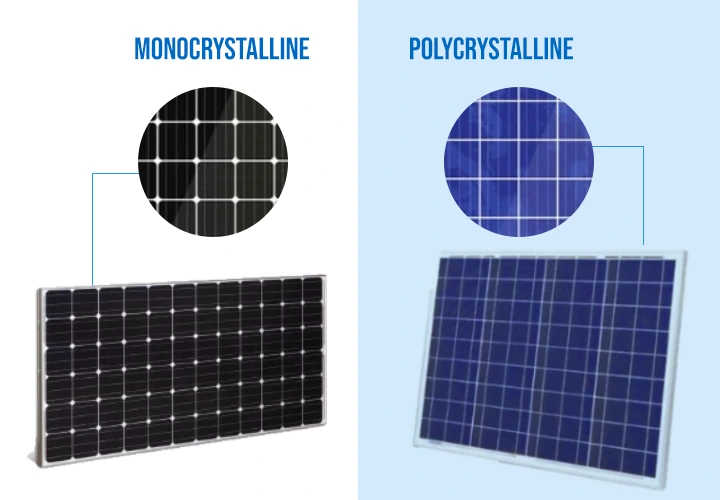As a homeowner, switching to solar energy is the best option considering the recent economic and environmental scenario. There are two common types of photovoltaic cells used to convert sunlight into electricity: Monocrystalline and polycrystalline solar panels. The solar cells that constitute a solar panel can be made from layers of silicon, phosphorus, and boron. Domestic solar companies offer both types of solar panels depending upon your energy needs, climate conditions and budget. In this blog, we have discussed the two types of solar panels in detail:
Monocrystalline Solar Panels
As the name suggests, solar PV cells are made of single silicon crystals and are sometimes referred to as “mono solar panels.” They are considered of better quality due to their high efficiency and sleek aesthetics.
Polycrystalline Solar Panels
The solar PV cells of these panels are made of multiple silicon crystal fragments that are melded together. They are also known as “multi-crystalline panels” or “poly panels.” They are preferred more by customers as they are more affordable than their counterparts.
Monocrystalline vs Polycrystalline Solar Panels
The following is a compiled list of major differences between the two types of panels:
| Criteria | Monocrystalline Solar Panels | Polycrystalline Solar Panels |
|---|---|---|
| Material and Manufacturing | Formed of a single crystal structure | Made from multiple crystal structures. |
| The cylindrical ingots are cut from a large silicon crystal to form high-purity silicon wafers. | The raw silicon is melted and poured into square moulds to form ingots. After solidification, the ingots are sliced into thin layers. | |
| Appearance | They are black or dark blue. | They usually have a bluish tint. |
| Have a uniform and sleek appearance with rounded edges. | They have a mosaic-like appearance with an undulating surface. | |
| Power Efficiency | Higher efficiency rates of almost 19-21%. | Lower efficiency rates from 15-17%. |
| The single-crystal structure provides better electron flow, resulting in improved performance in low-light conditions | The multiple-crystal design leads to lower electron mobility. | |
| Lifespan | Lasts for 25-40 years. | Lasts for 20-35 years |
| Cost | They are more expensive to manufacture. | They are more cost-effective. |
| Temperature Performance | They have a lower temperature coefficient (0.35% per °c). | They have a higher temperature coefficient (0.4% per °c). |
| Slightly better performance in high temperatures. | Lower performance in high-temperature conditions. |
Monocrystalline or Polycrystalline- Which is Better?
When choosing between monocrystalline and polycrystalline solar panels, factors such as available space, budget, and desired efficiency should be considered. Considering the solar panel installation cost, proper research is required to decide the best energy investment for your property.
Advantages of Monocrystalline Solar Panels
- Energy efficient
- Heat-resistant
- Lower power output reduction over time
- More space-efficient
Disadvantages of Monocrystalline Solar Panels
- Expensive
- High carbon footprint
Advantages of Polycrystalline Solar Panels
- Affordable
- Less wastage in the manufacturing process
- Low carbon footprint
Disadvantages of Polycrystalline Solar Panels
- Low heat resistance
- Lower energy efficiency
- Slightly less space-efficient
In light of this information, we offer solar installation for a home specific to your energy and space requirements. Moreover, we also find the best deals and government rooftop solar subsidies for the highest return on investment. To learn more about our services, contact us today.


 from Webdoux
from Webdoux